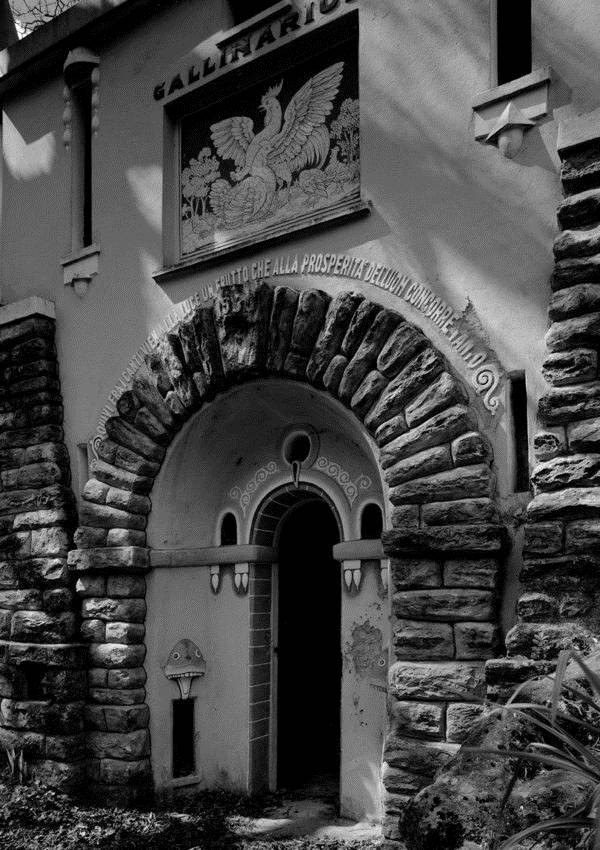 Gallinarium, 1930-36 (Photo Vàclav Šedy).
Gallinarium, 1930-36 (Photo Vàclav Šedy).
Dioli began to build his home on Sasso Gianaccio in 1926, the year he bought the land and built the square, stone masonry north-east tower.
Unfortunately Dioli was unable to complete the enlargement of the tower which remained the only building of the entire project, due to the financial collapse of the bank where he had placed his life savings around 1930.
The tower contained three romms, one on top of the other, only two of which were habitable.
Erminio lived on the ground floor and had his studio with his various tools in the room above.
The most significant works of the Castle are the eight allegorical graffiti, two on each wall of the tiny first floor room created in 1951: the artist depicted himeslf as an angelic figure holding his work tools and is taming monstrous dragons which are facing him.
He portrayed himself as a botanist and architect, decorator and painter, graffiti artist and mason or builder.
On the other hand, the dragon is the symbol of creative energy and of the vital, powerful chaotic movement.
The dragon is a hybrid which represents the vital, destructive force of nature, an eclectic figure which envelops the power of the universe and throws it unevenly on to the earth.
Thus, the dragon is said to represent a primordial energy which unites the spirit and material and which the angel through its creative, contructive work and design organises, structures, shapes, and orders into a cosmos and ordered universe: the sum of philosophic thought, poetry and the aesthetic concept of the artist from the Valmalenco.
In 1930, Dioli completed building the hen house at Sasso Gianaccio, called the Gallinarium, a small building with a majestic round-arched portal which appears to be the transfiguration of a mausoleum.
In the rock beneath the tower, the architect constructed a grotto in which some shelves held vases of overhanging flowers and other objects.
The grotto was the maestro's special place for reflection.
Above the entrance he had engraved the inscription: “God is everything, divinity and matter, the unknown spirit, as the marvellous figure of cause and effect, eternal in time, infinite in his measure, perfect in his shape, sublime in his figura, supreme inhis wishes, the utmost in good and and arcanumin power."
Lastly, the castle was embellished by a botanical garden and vegetable garden which Dioli tended for many years to fulfil his needs to survive and, as an artist, to create a true universe of shapes to contemplate and to use as inspiration.
 Allegoric graffito.
Allegoric graffito.
The space at the “Castèl” was where Dioli could express his creativeness linked to the production, the rhythms and the shapes of the earth, a place which not only welcomed numerous plants and flowers, but also a true architectural work based on a system of irrigation which guarnateed blossoms from February to December.
It mirrored the natural and apparently disorganic aspect of an Alpine wood (like the gardens of some of the villas designed by the maestro).
The land ran along a slope and he had created a little path from which the various plant species could be admired as in a proper botanical garden, the main grotto and a smaller one, the wooden fountains, the little artificial lake, the Gallinarium and naturally, the enchanting view over the Valmalenco.
The garden is a sort of Edenb, a sacred space in which Dioli took refuge in his later years in order to breathe and appreciate the pure beauty of nature.